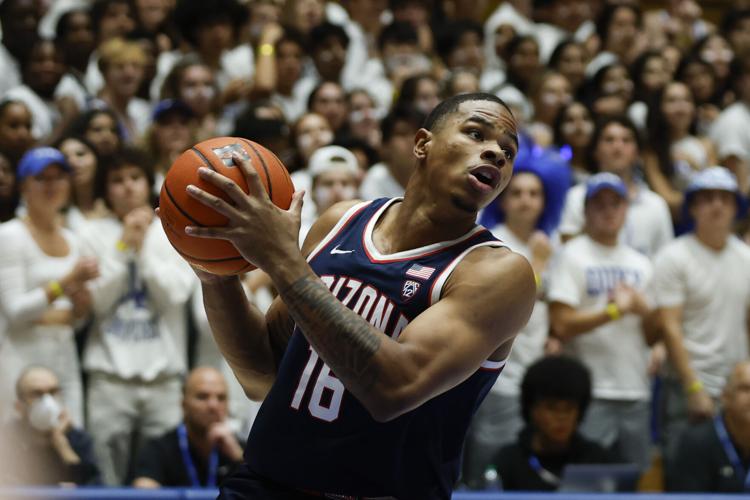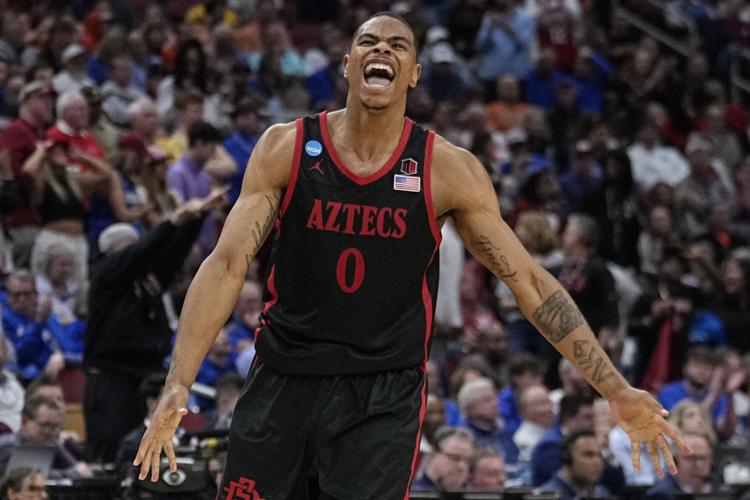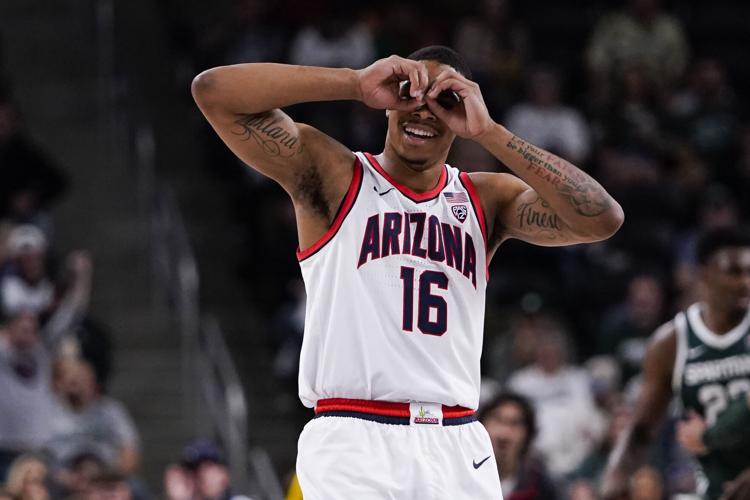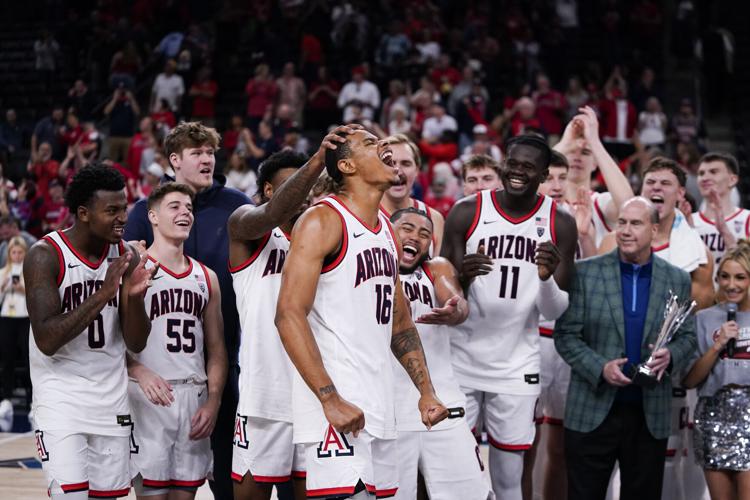Ever since 10-year-old Keshad Johnson first threw on a No. 16 jersey, nudged by the coach of his older brother’s middle-school basketball team in an emotional moment at an Oakland YMCA, something felt different.
In that number, there was fuel to make a years-long leap from virtually unheard-of high school player to college role player to NBA Draft prospect. To become ubiquitous on the court, springing to protect the rim, racing out to defend the perimeter and driving inside offensively with the same ferociousness regardless of opponent.
There was fuel for Johnson to help, in the latest example, drive the Arizona Wildcats to a 6-0 start this season.
Johnson was largely that guy at San Diego State, too, helping the Aztecs make a surprising run to last season’s NCAA title game, even though he wore No. 0 because modern NCAA rules didn’t allow jersey numbers higher than five before this season.

Former San Diego State forward Keshad Johnson celebrates the Aztecs' win over Alabama that pushed SDSU to the Elite 8 of the 2013 NCAA Men's Basketball Tournament in late March. Johnson transferred to Arizona after the season, joining a 2023-24 UA team packed with both experience and depth.
He was always that guy because Keshad Johnson is 16, and he is also 0.
Zero, as in “O,” for Oakland. The city where, on Nov. 11, 2011, Kenny Johnson Jr. was a 14-year-old eighth-grader walking home through the Lower Bottoms neighborhood from a weekend sleepover with friends when two men pulled up and fired 10 bullets into him.
Mistaken identity, Keshad Johnson says now. A conflict between gangs that his older brother wasn’t even a part of.
“At the time of being 14, playing sports, you start developing muscles and looking like older people,” Keshad said. “You just look a part (of it) being in a neighborhood where we’re from.”
Kenny, four years older and a hero to Keshad, crumpled on the ground. His father later said during a courtroom sentencing hearing that neither police nor an ambulance were quick to respond.
“My son (was) just sitting there,” Kenny Johnson Sr. said, according to the San Diego Union-Tribune. “He couldn’t move his legs. He couldn’t move at all.”
About 35 shell cases were found at the site, Keshad said.
“A couple of couple bullets may have went through but I believe they found seven” in his body, Keshad says. “The most significant one was the one that grazed his spine and left him semi-paralyzed.”
Somehow, Kenny remained alive. But the family was told he would probably never walk again, cutting short a basketball career that was so promising, Keshad said, that high schools all over Oakland were trying to recruit him.
“He was for sure one of the best middle school players in Oakland,” Keshad says. “Everybody knew it. He was already jumping on the rim, grabbing the rim and everything. Once that growth spurt would have hit him in high school, the sky was the limit.”
Instead, Kenny couldn’t walk. His No. 16 jersey sat idle after Nov. 6, 2011.
Until a few weeks after the shooting, when Kenny was still in the hospital, and his coach turned toward his 10-year-old little brother during a game.

Arizona forward Keshad Johnson (16) lets out a scream after a basket helping the Wildcats begin to pull ahead of the Southern Jaguars in the first half on Nov. 13 at McKale Center.
“I put on the No. 16,” Keshad said. “The first game, they let me replace his spot. They threw me in the game with 10 seconds left before halftime and (with the clocking ticking) 5-4-3-2-1, I hit a deep 3. All net.
“I just felt like angels was with me. I felt like it was a greater power, like it was God giving me that moment, like `You’ve got to take the throne.’ It was one of those situations. So from then on, I just knew it was my chance. His dream was to play basketball, but it got taken away from him. So from there, I just took basketball serious.”

The tattoo on Arizona men’s basketball forward Keshad Johnson’s left arm includes his nickname, “Showtime,” as well as a date that holds great importance to him and his family. Nov. 6, 2011, was the date his older brother, Kenny — then just a 14-year-old eighth-grader — was walking home from a weekend sleepover with friends when two men pulled up and fired 10 bullets into him. Kenny survived, but it would take time until he could again, with the help of crutches.
The moment of transition is engraved in Johnson’s left arm. There, a tattoo features a basketball set against a brick wall, partially wrapped with an upper ribbon that says “Showtime” and a lower ribbon that says “11-6-2011,” the date Kenny was shot.
The “Showtime” part didn’t come until years later, thanks to high school teammates who gave their increasingly splashy teammate the nickname, but the date immediately became part of what defines him.
Even with his family having moved after the shooting to the safer ground of nearby San Leandro, where Johnson attended middle school, Keshad still found himself drawn back to Oakland.
There, he took extracurricular afterschool activities and played basketball relentlessly, developing his instinctive, hustle-filled game not in finely crafted developmental programs but in pickup games around town whenever and however he could.
With his family still “in and out of the hospital,” Johnson said a number of aunts, uncles and godparents helped him, though he commuted to Oakland largely by himself, driven to grow in the city he still calls his home today.

Arizona forward Keshad Johnson (16) reacts after being named MVP of the Acrisure Classice in Palm Desert, California. Johnson had 13 points and 10 rebounds as the No. 3 Wildcats defeated No. 21 Michigan State 74-68 on Thanksgiving Day.
“I still had a connection with Oakland,” Johnson said. “I was traveling Oakland every day, still playing basketball in Oakland every day, taking public transportation, the AC Transit bus and BART. I feel like that’s when I matured a lot.”
Eventually, Johnson enrolled at Envision Academy, an Oakland charter school. He kept starring in basketball, though the team’s low profile kept him still largely off the college recruiting radar.
But after leading Envision to the Class V CIF playoffs as a junior in 2018, Johnson played club ball on more high-profile club teams. Don Manning, who became Johnson’s club coach and remains a mentor to him today, placed him on a Sacramento-based team and the even-longer commute still wasn’t an issue.
“When he was playing for me, he was catching the train out here and doing his homework in the airport,” Manning said. “We’d fly back into Sacramento on a six-hour flight with a layover. He’d have to spend the night at my house and then get on the Amtrak and then go to school the same day.

Arizona forward Keshad Johnson reacts during the first half of Arizona’s Thanksgiving Day win over Michigan State in Palm Desert, California.
“The main thing I can say about him is that he just does what’s necessary to be done.”
Same thing applied on the court, Manning said: Johnson simply gave what his team needed.
“The wonderful thing about him is that in this era where kids feel like they have to play a certain way or show off a certain skillset, Keshad has always just played to win,” Manning said. “That’s what separates him. That’s what will continue to separate him from his peers. He’s just a winner.
“It is hard to really identify specifically what he’s doing. You can visually see what he’s doing even if there’s not a statistic for it. When it’s time for a play to be made, he’s gonna make a play, whether it’s a steal, whether it’s a block, whether it’s hitting the open shot… whatever it takes, that’s what he’s doing.”
By the time Manning took Johnson and his club-ball teammates to that summer’s Fab 48, then a prestigious late-July club tournament in Las Vegas, the secret was fully out. Johnson picked up 19 scholarship offers that weekend.

Arizona forward Keshad Johnson (16) jumps to make the shot as UT Arlington forward Dwayne Koroma (11) defends in the first half of the Wildcats' win over the Mavericks on Nov. 19 at McKale Center.
Less than four months later, on Nov. 6, 2018, exactly seven years to the day when Kenny Jr. was shot, Keshad announced on social media he was committing to San Diego State.
Despite also having played against stiffer competition as a high school senior by transferring to San Leandro High School, Johnson still showed up at San Diego State as a project of sorts. He played sparingly as a freshman in 2019-20 and into a small role as a sophomore in 2020-21.
But he started his final two seasons for the Aztecs and led them with 14 points in the NCAA title game against Connecticut, having funneled his wide-ranging enthusiasm and athleticism into the Aztecs’ perennially strong defense over four seasons in San Diego.
“He takes pride in what he’s able to do defensively, but (at SDSU) there was also sound fundamental principles behind it as well,” Manning said. “What they do defensively and the emphasis they place on it — and what he could already could do naturally — set him up to be successful for as long as he plays the game.”
Johnson left San Diego State with a degree last summer and opted to spend the extra year of eligibility granted to 2020-21 “COVID-year” participants at Arizona, where Manning said he’s seen Johnson already take another leap.
Manning can see it on Johnson’s face, in his body language, watching No. 16 dart all around the court.
“When you watch him play D, it looks like he’s having fun, just like if you’re on a fast break dunking the basketball,” Manning said. “When I watch (Arizona’s) games, it looks like everybody taking that same kind of joy on the defensive end. They’ve been as impressive what they’re doing on the defensive end, possession to possession, as they have been offensively.”

Kenny Johnson
Maybe that No. 16 jersey has something to do with it. Johnson said he’s grateful the NCAA allowed him to wear the number for his final college season, when he’s trying to lead another team deep into the NCAA Tournament and increase his NBA chances at the same time.
But Kenny isn’t done with his basketball jersey, either. He can walk today with the help of crutches, something Johnson says is the result of the family’s prayers and “the grace of God,” and he’s playing wheelchair basketball for the powerhouse Golden State Road Warriors club.
While a message to Kenny for this story was not returned, he posted in his online Road Warriors bio that after being invited to a wheelchair practice, “I immediately fell in love with my old passion of being competitive in playing basketball.”
Sounds familiar, doesn’t it?
Last season, Keshad had a chance to see Kenny flash that passion in San Diego, of all places.
Against the UA’s men’s wheelchair outfit, of all teams.
A year later, Keshad is playing for Arizona, and wearing Kenny’s old No. 16.
“Here I am,” Keshad says. “Everything is pretty much working out.”
Arizona Basketball Postgame Press Conference | Keshad Johnson & Kylan Boswell | Nov. 6, 2023 vs. Morgan State (Arizona Athletics YouTube)
"This is a crazy, eye-opening experience," says new Wildcat Keshad Johnson, a transfer to Arizona this season from San Diego State. Video courtesy Arizona Athletics (Via X/Twitter)
VIDEO: Arizona head coach Tommy Lloyd speaks at Pac-12 Media Day on Wednesday, Oct. 11, on how Keshad Johnson developed at San Diego State, and what that “growth” means with him now at Arizona. (Video courtesy Pac-12 Networks).












